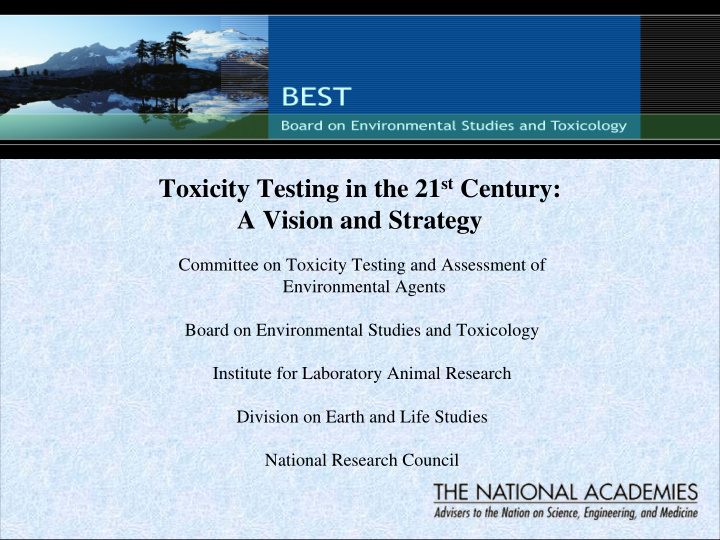



Toxicity Testing in the 21 st Century: A Vision and Strategy Committee on Toxicity Testing and Assessment of Environmental Agents Board on Environmental Studies and Toxicology Institute for Laboratory Animal Research Division on Earth and Life Studies National Research Council
NRC Report (2007) • Develop efficient, high throughput testing strategies to assess the potential health risks of large numbers of environmental agents to which people may be exposed • Exploit scientific advances in biology and toxicology to achieve risk assessments that are more relevant to human populations www.nas.edu
Components of the Vision Computational toxicology In vitro tests
Endorsement by the Scientific Community Endorsement by the Scientific Community Collins, F.S., Gray, G.M. & Bucher, J.R. (2008), Science (Policy Forum). Vol. 319. pp. 906 - 907
Reaction from the Legal Community Reaction from the Legal Community
Reaction from the Animal Law Community Reaction from the Animal Law Community International Symposia on Challenges and Opportunities in Implementation September 12, 2009 June 21-23, 2010 June 29-30, 2009 November 5, 2009 “There is widespread support for the NAS vision. There are also real but surmountable challenges in moving the vision into routine regulatory practice. Progress is being made in producing the necessary science and knowledge base — we need to redouble our efforts to see that these insights carry over into the worlds of law and policy.” Paul Locke, Johns Hopkins University Centre for Alternatives to Animal Testing
Reaction from Experts in Risk Assessment “Suresh Moolgavkar, our Area Editor for Health Risk Assessment, asked six experts with different perspectives to comment on the paper. Each praises the vision and offers suggestions for making it more useful.” Michael Greenberg & Karen Lowrie, Editors
Federal Agency Commitment http://www.epa.gov/osa/spc/toxicitytesting/docs/toxtest_strategy_032309.pdf
Resources Needed to Implement EPA’s Strategic Plan “This strategic plan describes an ambitious and substantive change in the process by which chemicals are evaluated for toxicity. The NRC (2007) suggested that such a transformation would require up to $100 million per year in funding over a 10 - 20 year period to have a reasonable chance of reaching its goals.” U.S. EPA, 2009
Dual Motivation for Change Animal Welfare Better Science
Expert Panel on the Integrated Testing of Pesticides “Integrated testing, using in vitro data from diverse fields of study, represents an exciting means by which we can refine and reduce in vivo toxicity testing requirements. By this approach, it may be possible to avoid the need for full batteries of animal-based toxicity tests for each pesticide under assessment, while still maintaining defensibility of the assessments.” http://www.scienceadvice.ca/pesticides.html
Future Directions in the European Union “This convergence of factors, coupled with the need to evaluate the safety of an increasingly large number of chemicals and their mixtures, has prompted some of the world’s leading scientific authorities to call for a fundamental paradigm shift in toxicology . . . .” http://cordis.europa.eu/documents/documentlibrary/106691831EN6.pdf
Making the Vision a Reality • National/international coordination of development of the scientific foundation on which the NRC vision rests • Consideration of the implications of the vision for application of current and future regulatory statutes • Re-orientation of risk assessment practice to focus on prevention of perturbation of toxicity pathways • Ongoing oversight by the NRC, with progress reports and mid-course corrections over the next 5 – 10 years
Recommend
More recommend